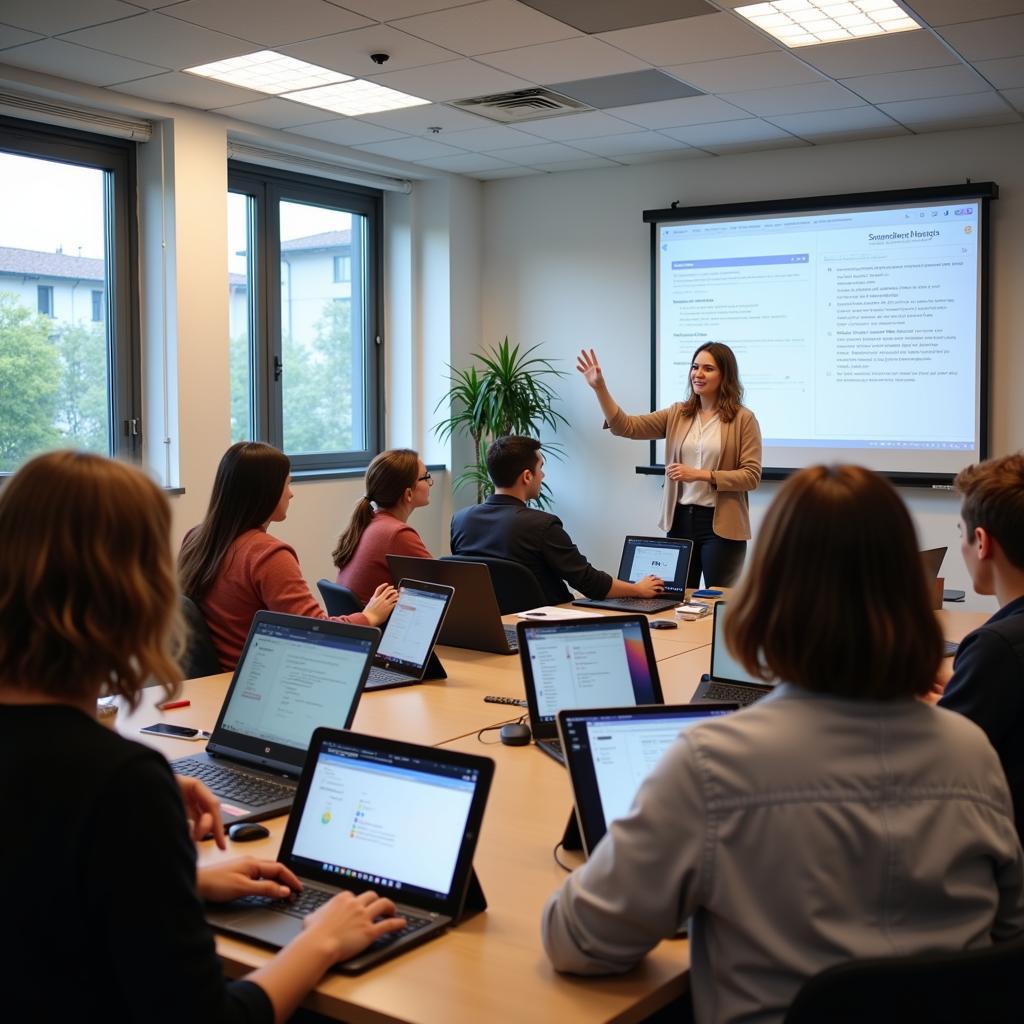Technology’s role in education has become an increasingly common topic in IELTS Writing Task 2, appearing in approximately 15% of recent exam questions. This trend reflects the growing importance of digital learning in our contemporary educational landscape. Let’s examine one of the most frequently appearing question types on this subject.
The role of technology in modern education has transformed dramatically in recent years, making it a crucial topic for IELTS candidates to master.
Some people believe that technology has made teaching and learning more effective, while others think it has created distractions and reduced the quality of education. Discuss both views and give your opinion.
Analysis of the Question
This question requires:
- Discussion of both positive and negative impacts of technology in education
- A clear personal stance
- Examples to support arguments
- A balanced approach to both viewpoints

Sample Essay 1 (Band 8.0)
The integration of technology in education has sparked considerable debate regarding its effectiveness. While some argue that technological tools enhance the learning experience, others contend that they diminish educational quality. I believe that when properly implemented, technology significantly improves educational outcomes despite certain challenges.
Modern educational technology has revolutionized teaching methods in several ways. Interactive learning platforms and digital resources have made education more engaging and accessible to students worldwide. For instance, virtual laboratories allow students to conduct complex experiments safely and cost-effectively, while adaptive learning software provides personalized instruction based on individual progress. Moreover, the impact of technology on childhood development has shown that digital literacy skills acquired early can enhance future career prospects.
However, critics raise valid concerns about technology’s potential drawbacks. The most significant issue is that devices can become sources of distraction, with students potentially spending more time on social media or games than educational content. Additionally, excessive screen time may lead to reduced face-to-face interaction and potential health issues. Some educators also worry about the digital divide, where students from lower-income backgrounds might have limited access to technology.
Nevertheless, I maintain that the benefits of educational technology outweigh its disadvantages. The key lies in implementing proper guidelines and maintaining a balanced approach. Schools can establish clear policies regarding device usage while role of technology in modern education systems continues to evolve. Furthermore, teachers can be trained to effectively integrate technology into their teaching methods while preserving traditional educational values.
In conclusion, while technology in education presents certain challenges, its positive impact on learning outcomes is undeniable when properly managed. The focus should be on developing frameworks that maximize benefits while minimizing potential drawbacks.
Sample Essay 2 (Band 6.5)
These days, people have different opinions about using technology in education. Some think it helps students learn better, but others say it causes problems. I think technology is mostly good for education but we need to be careful how we use it.
Technology makes learning easier in many ways. Students can find information quickly on the internet and watch educational videos. For example, in my country, many students use online resources to study English and other subjects. Also, Teacher shortages and recruitment problems can be solved by using online teaching platforms.
However, there are some problems with technology in schools. Many students get distracted by social media and games during class. Sometimes they don’t pay attention to teachers because they are looking at their phones. Also, some students cannot afford computers or internet at home, which is not fair.
I believe technology is good for education if we use it correctly. Teachers should make rules about when to use devices in class. Schools should also help students who cannot afford technology. This way, everyone can benefit from modern education tools.
In conclusion, while technology can cause some problems in education, the advantages are greater than the disadvantages. We should focus on using technology in ways that help students learn better.
Key Vocabulary
- Integration (n) /ɪntɪˈɡreɪʃən/ – the process of combining things effectively
- Interactive (adj) /ˌɪntərˈæktɪv/ – involving direct participation
- Adaptive learning (n) /əˈdæptɪv ˈlɜːnɪŋ/ – personalized learning that adjusts to student needs
- Digital divide (n) /ˈdɪdʒɪtl dɪˈvaɪd/ – gap between those with and without access to technology
- Implementation (n) /ˌɪmplɪmenˈteɪʃən/ – the process of putting a plan into action
Consider practicing with these similar topics:
- The impact of artificial intelligence on education
- Online learning versus traditional classroom teaching
- The role of social media in education
Share your practice essays in the comments section for feedback and discussion!